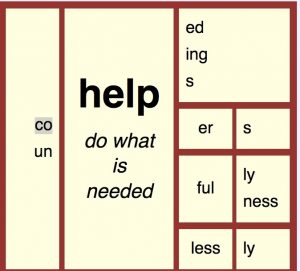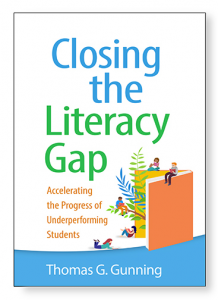Along with being taught how to sound out words, students should be taught, from the earliest stages, the morphology of words. As I noted in the last blog, being aware of the underlying morphemic structures of words aids both reading and writing. For the word does, understanding that it is composed of the morphemes <do> + <es> and is related to the word do, should foster accurate spelling and reading. Likewise, understanding that been is composed of the morphemes <be> + <en> and is related to be should facilitate the accurate spelling and reading of been (Hegland, 2021).
One device that is used to highlight the morphemes in related words is the word sum. Word sums are created by assembling words that belong to the same family and then breaking down the words into their morphemes, which are their meaningful parts: <mor>+<pheme>+<s>. The first task is to assemble all the words that you believe belong to the word family you are investigating. Listed below are the word sums for the help family. A good source for finding the forms of a base or root is Neil and Louise Ramsden’s Word Searcher http://www.neilramsden.co.uk/spelling/. However, once you have found the listing of words or have created your own, you must determine whether the words belong to the word family you are working with. Word Searcher automatically lists all the words from its database that contain the letter sequence you entered. For the base bene, Word Searcher listed 26 matches. However, it included the word beneath. It was up to me to decide if beneath belongs to the bene word family. Since its meaning is very different from that of bene, which is defined as “well” or “good,” I judged that it was not part of the bene family. If in doubt, you can also check its etymology. The website etymonline https://www.etymonline.com/ provides the word histories for thousands of words.
Word Sums for the Help Family
help + ing helping
help + er helper
help +er + s helpers
co + help + er cohelper
co + help + er +s cohelpers
help + ful helpful
un+help+ful
help + ful + ness helpfulness
help + ful + ly helpfully
help+less helpless
help + less + helplessly
By creating words sums, students learn multiple words instead of just one. They boost their ability to use both syllabic and morphemic analysis and also learn how to analyze words. In this example, I constructed virtually all the possible word sums for help. Depending upon the age and knowledge of your students, you can limit the number and complexity of word sums. Using the word sums, students can then construct a word matrix for help. Steps for constructing a word matrix are listed below
- The base word is written in the center of the matrix and is accompanied by a brief definition.
- Prefixes are placed in the cells to the left.
- Suffixes and any secondary bases are placed in cells to the right. If there are multiple prefixes or suffixes or bases, they are placed in separate columns in the order in which they appear in the word. For instance, in the Word Matrix for help, ness and ly are placed in separate columns that appear after ful so as to form the words helpfulness and helpfully. Examples of completed matrices along with a tool for creating matrices, Mini Matrix-Maker, can be found at http://www.neilramsden.co.uk/spelling/matrix/index.html. The word matrix for help was created with the Mini Matrix-Maker. It is presented below.
Because constructing word sums and matrices is challenging and interactive, chances are students will find it motivating. I can imagine teams working together to construct matrices.
Created with Mini Matrix-Maker, at www.neilramsden.co.uk/spelling/matrix
On a personal note, here is an announcement for my recently published text. Now available in both print and as an e-book.
Closing the Literacy Gap: Accelerating the Progress of Underperforming Students
Packed with practical tools, this book provides K–6 educators with a research-based framework for accelerating the reading and writing growth of underperforming students. Strategies and resources are included for building foundational skills, comprehension, and vocabulary; engaging students with independent reading and periodicals; developing writing; and implementing tutoring and other extra

